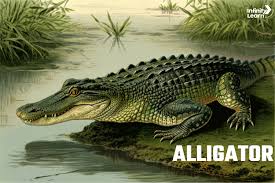Exploring the Word “Alligator” in the Spanish Language
Introduction
The word “alligator” is widely recognized in English, but its Spanish counterparts are rich and varied, reflecting regional differences and the diverse habitats of these fascinating reptiles. In Spanish-speaking countries, multiple terms are used to describe alligators, each with its unique cultural and geographic significance. This article delves into the different Spanish words for “alligator,” their meanings, and the contexts in which they are used.
Spanish Terms for Alligator
- Caimán The most common Spanish word for “alligator” is “caimán.” This term is widely used across Spanish-speaking countries, particularly in Central and South America. The word “caimán” can refer to various species within the alligator family, including the American alligator and several species of caimans found in South America.Example: “Es muy poco probable que un caimán haya hecho esto.” (It’s very unlikely that an alligator could have done this.)
- Aligátor Another term used in some regions is “aligátor,” a direct borrowing from the English word “alligator.” This word is less common but still understood, especially in contexts where the distinction between an alligator and a crocodile needs to be clear.Example: “Los aligátores pueden vivir en manglares.” (Alligators can live in mangroves.)
- Yacaré In South America, particularly in countries like Argentina, Paraguay, and Brazil, the word “yacaré” is often used to describe alligators. The yacaré is a specific species of caiman native to these regions, known for its resilience and adaptability in various water environments.Example: “Aquí se pueden encontrar varias especies de monos, pájaros y yacarés.” (Here you can find several species of monkeys, birds, and alligators.)
- Lagarto In Central America, Mexico, and even in Spain, the word “lagarto” is sometimes used to describe alligators, although it technically refers to lizards. In these regions, “lagarto” can be used informally to refer to large reptiles, including alligators.Example: “No te bajes del bote. Por aquí hay muchos lagartos.” (Don’t get off the boat. There are many alligators around here.)
Cultural Significance and Usage
The diversity of words for “alligator” in Spanish reflects the wide geographic distribution of these reptiles and their importance in various cultures. For instance, in South America, the yacaré is not only a part of the natural ecosystem but also a symbol in folklore and local traditions. In contrast, the term “caimán” might evoke images of the powerful reptiles found in the Amazon Basin, while “aligátor” might be used in scientific or formal contexts to distinguish between different species.
In addition to their literal meanings, these words can also carry metaphorical or symbolic connotations. For example, in some Latin American cultures, a “caimán” might symbolize cunning or survival, reflecting the animal’s ability to thrive in challenging environments.
Conclusion
The Spanish language offers a rich vocabulary to describe the alligator, with terms like “caimán,” “aligátor,” “yacaré,” and “lagarto” each carrying their own regional and cultural significance. Whether you’re in the wetlands of South America, the mangroves of Central America, or a classroom in Spain, these words provide a fascinating glimpse into the ways different cultures relate to one of nature’s most formidable creatures. Understanding these terms not only enriches your vocabulary but also deepens your appreciation for the diverse linguistic and cultural landscapes of the Spanish-speaking world.




